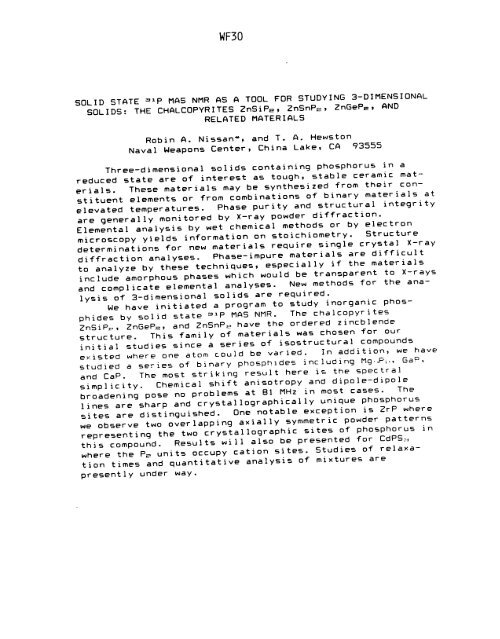th - 1987 - 51st ENC Conference
th - 1987 - 51st ENC Conference
th - 1987 - 51st ENC Conference
Create successful ePaper yourself
Turn your PDF publications into a flip-book with our unique Google optimized e-Paper software.
WF30<br />
SOLID STATE ~P MAS NMR AS A TOOL FOR STUDYING 3-DIMENSIONAL<br />
SOLIDS: THE CHALCOPYRITES ZnSiPe, ZnSnPe, ZnGePe, AND<br />
RELATED MATERIALS<br />
Robin A. Nissan', and T. A. Hewston<br />
Naval Weapons Center, China Lake, CA 93555<br />
Three-dimensional solids containing phosphorus in a<br />
reduced state are of interest as tough, stable ceramic mat-<br />
erials. These materials may be syn<strong>th</strong>esized from <strong>th</strong>eir con-<br />
stituent elements or from combinations of binary materials at<br />
elevated temperatures. Phase purity and structural integrity<br />
are generally monitored by X-ray powder diffraction.<br />
Elemental analysis by wet chemical me<strong>th</strong>ods or by electron<br />
microscopy yields information on stoichiometry. Structure<br />
determinations for new materials require single crystal X-ray<br />
diffraction analyses. Phase-impure materials are difficult<br />
to analyze by <strong>th</strong>ese techniques, especially if <strong>th</strong>e materials<br />
include amorphous phases which would be transparent to X-rays<br />
and complicate elemental analyses. New me<strong>th</strong>ods for <strong>th</strong>e ana-<br />
lysis of 3-dimensional solids are required.<br />
We have initiated a program to study inorganic phos-<br />
phides by solid state ~P MAS NMR. The chalcopyrites<br />
ZnSiP~,, ZnGePe, and ZnSnPe have <strong>th</strong>e ordered zincblende<br />
structure. This family of materials was chosen for our<br />
initial studies since a series of isostructural compounds<br />
existed where one atom could be varied. In addition, we have<br />
studied a series of binary phosphides including Mg-,P;., GaP,<br />
and CaP. The most striking result here is <strong>th</strong>e spectral<br />
simplicity. Chemical shift anisotropy and dipole-dipole<br />
broadening pose no problems at 81 MHz in most cases. The<br />
lines are sharp and crystallographically unique phosphorus<br />
sites are distinguished- One notable exception is ZrP where<br />
we observe two overlapping axially symmetric powder patterns<br />
representing <strong>th</strong>e two crystallographic sites of phosphorus in<br />
<strong>th</strong>is compound. Results will also be presented for CdPS::~<br />
where <strong>th</strong>e Pe units occupy cation sites. Studies of relaxa-<br />
tion times and quantitative analysis of mixtures are<br />
presently under way.













